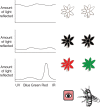Structural colour and iridescence in plants: the poorly studied relations of pigment colour
- PMID: 20142263
- PMCID: PMC2850791
- DOI: 10.1093/aob/mcq007
Structural colour and iridescence in plants: the poorly studied relations of pigment colour
Abstract
Background: Colour is a consequence of the optical properties of an object and the visual system of the animal perceiving it. Colour is produced through chemical and structural means, but structural colour has been relatively poorly studied in plants.
Scope: This Botanical Briefing describes the mechanisms by which structures can produce colour. In plants, as in animals, the most common mechanisms are multilayers and diffraction gratings. The functions of structural colour are then discussed. In animals, these colours act primarily as signals between members of the same species, although they can also play roles in camouflaging animals from their predators. In plants, multilayers are found predominantly in shade-plant leaves, suggesting a role either in photoprotection or in optimizing capture of photosynthetically active light. Diffraction gratings may be a surprisingly common feature of petals, and recent work has shown that they can be used by bees as cues to identify rewarding flowers.
Conclusions: Structural colour may be surprisingly frequent in the plant kingdom, playing important roles alongside pigment colour. Much remains to be discovered about its distribution, development and function.
Figures



References
-
- Bagnara JT, Fernandez PJ, Fujii K. On the blue coloration of vertebrates. Pigment Cell Research. 2007;20:14–26. - PubMed
-
- Bitton PP, Dawson RD. Age-related differences in plumage characteristics of male tree swallows Tachycineta bicolor: hue and brightness signal different aspects of individual quality. Journal of Avian Biology. 2008;39:446–452.
-
- Chittka L, Raine N. Recognition of flowers by pollinators. Current Opinion in Plant Biology. 2006;9:428–435. - PubMed
-
- Gould KS, Lee DW. Physical and ultrastructural basis of blue leaf iridescence in four Malaysian understory plants. American Journal of Botany. 1996;83:45–50.
Publication types
MeSH terms
Substances
LinkOut - more resources
Full Text Sources
Other Literature Sources

